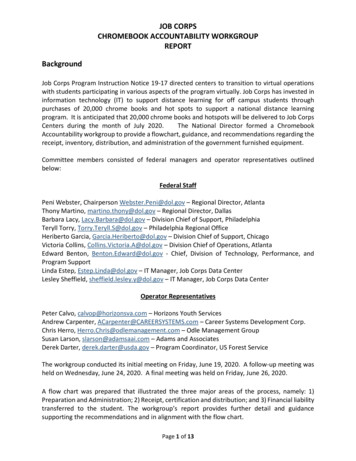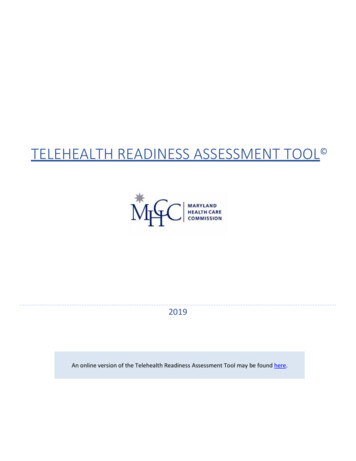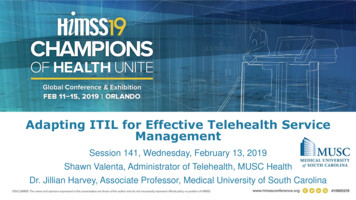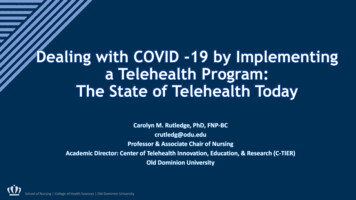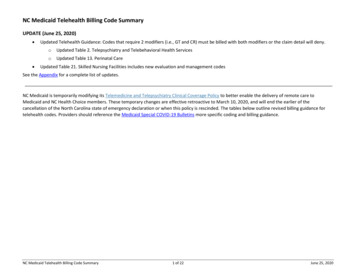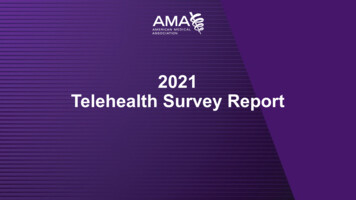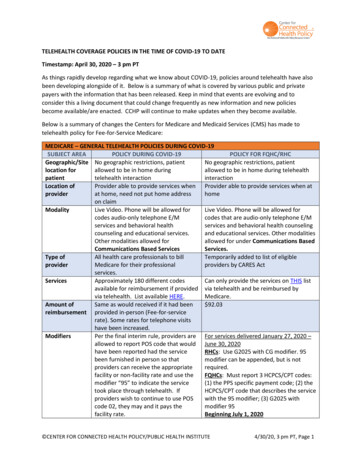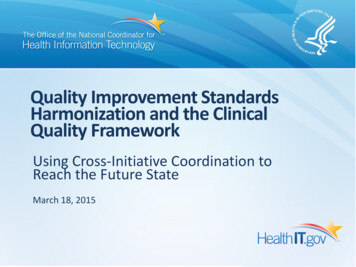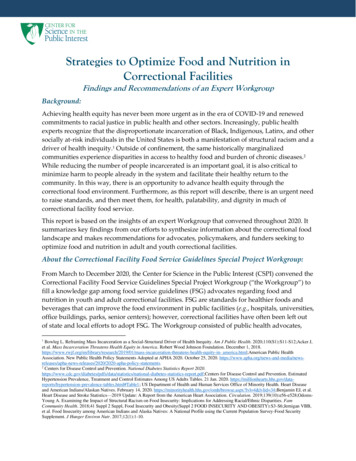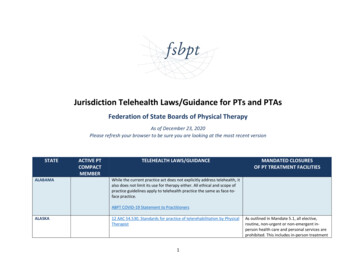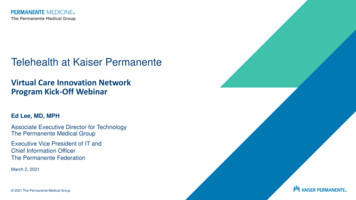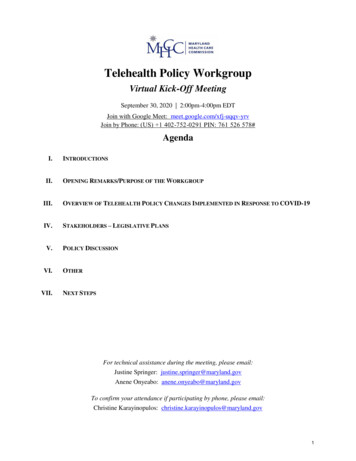
Transcription
Telehealth Policy WorkgroupVirtual Kick-Off MeetingSeptember 30, 2020 2:00pm-4:00pm EDTJoin with Google Meet: meet.google.com/xfj-uqqv-yrvJoin by Phone: (US) 1 402-752-0291 PIN: 761 526 578#AgendaI.II.INTRODUCTIONSOPENING REMARKS/PURPOSE OF THE WORKGROUPIII.OVERVIEW OF TELEHEALTH POLICY CHANGES IMPLEMENTED IN RESPONSE TO COVID-19IV.STAKEHOLDERS – LEGISLATIVE PLANSV.VI.VII.POLICY DISCUSSIONOTHERNEXT STEPSFor technical assistance during the meeting, please email:Justine Springer: justine.springer@maryland.govAnene Onyeabo: anene.onyeabo@maryland.govTo confirm your attendance if participating by phone, please email:Christine Karayinopulos: christine.karayinopulos@maryland.gov1
TELEHEALTH POLICY WORKGROUPVIRTUAL KICK-OFF MEETINGSEPTEMBER 30, 2020* Presented to the Maryland Hospital Association’s Stakeholder Innovation Group on September 16, 20202
REGULATORY RELIEF PROPELS TELEHEALTH TO THE FOREFRONT OFHEALTH CARE DELIVERY Rapid diffusion supported by the relaxation and expansion of telehealth policiesbrought on by a public health crisis Enabled by Executive Orders from Governor Hogan and waivers from the federal government In March, telehealth visits surged 50 percent nationally* Analysts estimate more than 900 million visits are expected by the end of 2020* According to research from Frost and Sullivan consultants – more information available .html3
KEY TELEHEALTH POLICY CHANGES HIPAA requirements – enforcement discretion on the use of certain technologies forthe good faith provision of telehealth services Telehealth waivers (some variances across payors) Patient location – lessening of geographical restrictions Licensing – greater flexibilities to practice across state lines Patient-provider relationship – redefined what constitutes a treatment relationship Eligible providers – expanded the provider types that can deliver telehealth services Types of services covered – increased the number of services payable when furnished via telehealth Cost-sharing – patient obligation eliminated or reduced4
HIPAA The Office for Civil Rights is exercising enforcement discretion and not imposingpenalties for noncompliance with the regulatory requirements under HIPAA Rulesagainst covered health care providers during the COVID-19 nationwide publichealth emergency Covered health care providers may use popular non-public facing applications todeliver telehealth services Video chat applications include: Apple FaceTime, Facebook Messenger video chat, Google Meet,Zoom, and Skype Text-based applications include: Signal, Jabber, Facebook Messenger, Google Hangouts, WhatsApp,iMessage Public-facing applications, such as Facebook Live, Twitch, and TikTok are notpermitted5
LICENSING AND MEDICAL LIABILITY COVERAGE Providers with an active license in good standing in another state may practiceacross state lines* The standard of care for telehealth treatment and documentation is the same as an in-person encounter Medical liability coverage for telehealth is dependent on a carrier’s policies Medical liability carriers may not cover the use of telehealth when the provider is deliveringtelehealth to a patient living outside of the state where the medical liability contract iswritten* Subject to licensing board requirements in each state6
PATIENT LOCATION AND SERVICE DELIVERY Telehealth services can be furnished usingaudio/visual or audio-only technologywherever the patient is located, including athome, regardless of rural designation Certain types of services no longer requireboth audio and video — visits can beconducted over the telephone or through aweb portal7
PATIENT AND PROVIDER RELATIONSHIP Providers may deliver telehealthservices to new and establishedpatients A patient may present photo identification,or a provider may use any other means toidentify a patient that would be acceptedfor an in-person encounter8
ELIGIBLE PROVIDERS AND COVERED SERVICES In general, more non-physician provider types can bill for an expanded list oftelehealth services, including licensed clinical social workers, clinical psychologists,physical therapists, occupational therapists, speech language pathologists,chiropractors, and dentists Home health agencies and hospice providers can provide more services throughtelehealth, as appropriate and consistent with the patient’s plan of care Patients that a provider determines should not leave home because of medical contraindications, ordue to suspected or confirmed COVID-19, qualify for home health benefits Providers can provide remote patient monitoring (RPM) services for patients withCOVID-19 and other chronic conditions9
COST SHARING Patient obligation reduced or waivedunder certain circumstances, includingpayor sponsored telehealth programs Subject to payor requirements and timelines;providers will not face administrative sanctionsby federal or State health care programs10
POST COVID-19 Momentum is increasing nationally to make some telehealth policy changes permanent; acomplete return to pre-COVID-19 policies viewed largely by providers and policy makers asunrealistic Variation is likely across states on permitted uses of telehealth Payors are beginning to signal that some dialing back will occur following the end of thefederal/State public health emergency The need for an evaluation of the impact of telehealth exists; timing is an issue Evaluations of telehealth are just beginning; NQF recommended domains: access to care, financialimpact, patient and provider experience, effectiveness The MHCC will convene a Telehealth Policy Workgroup (workgroup) this fall to deliberate ontelehealth policies post COVID-19 and identify stakeholder alignment opportunities11
THE END12
APPENDIX13
PAYOR TELEHEALTH POLICIESSlides 14 – 18Note: Italicized items represent temporary measures waiving certain use requirements for telehealth during theCOVID-19 public health emergency14
CategoryMaryland Medicaid Distant Site Providers(that can bill fortelehealth services) Locations(originating site: wherethe patient and possiblya provider are located;distant site: where theprovider is located) Somatic Services: As permitted by licensing boardLicensed Physical TherapistsIndividualized Education Program (IEP)/Individualized Family Service Program (IFSP)o Licensed Speech Pathologistso Licensed Occupational Therapistso Qualified Service Coordinators per COMAR 10.09.40 or COMAR 10.09.52DentistsBehavioral Health:*o Psychiatristso Psychiatric Nurse Practitioners (CRNP-PMH)o Advanced Practice Nurses (APRN-PMH)o LCPC, LCMFT, LCADC, LCPATo LCSW-Co In Outpatient Mental Health Clinics - only under supervision - LMSW or LCSW, LGPC, LGADC LGMFT, LGPATo In ASAM Level 1 outpatient SUD program, State licensed providers only – CAC-AD, CSC-ADo FQHCs who bill through the Specialty Behavioral Health Systemo Licensed Psychiatric Rehabilitation Programo Licensed Substance Use Disorder Intensive Outpatient Centerso Substance Use Disorder Residential Treatment ProgramOriginating siteo A college or university student health or counseling office;o A community-based substance use disorder provider;o A deaf or hard of hearing participant’s home or any other secure location as approved by the participant and the provider;o An elementary, middle, high, or technical school with a supported nursing, counseling or medical office;o A local health department;o A Federally Qualified Health Center (FQHC);o A hospital, including the emergency department;o A nursing facility;o A private office (physician, physician assistant, psychiatric nurse practitioner, nurse practitioner, or nurse midwife);o An opioid treatment program;o An outpatient mental health center (OMHC);o A renal dialysis center; oro A residential crisis services siteo Patient’s home or another secure locationDistant siteo Any secure, private location*Behavioral health providers must be enrolled in the Maryland Department of Health’s Specialty Behavioral Health Program15
CategoryMaryland Medicaid Audio-visualo Somatic Care: Services permitted within a provider’s scope of practice by the licensing boardo Physical Therapy (PT)o IEP/IFSP Physical Therapy, Occupational Therapy, Speech Therapy, Psychotherapy, Nutrition Serviceso Outpatient and Residential Substance Use Disorder Treatmento Dental Audio-only Telephoneo Somatic Services: Evaluation and management of an established patient (5-15 minutes)o Behavioral Health Evaluation and management of an established patient Psychotherapy: Individual and families Outpatient and Residential substance use disorder treatment Group Therapy Treatment Must have the following:o A camera that has the ability to manually, or under remote control, provide multiple views of a patient with the capability of altering the resolution, focus, and zoom requirements according tothe consultation;o Have display monitor size sufficient to support diagnostic needs used in the service via telehealth;o Bandwidth speed and image resolution sufficient to provide quality video to meet a minimum of 15 frames per second, or higher, as industry standards change;o Unless engaging in a telehealth communication with a participant who is deaf or hard of hearing, audio equipment that ensures clear communication and includes echo cancellation;o Creates audio transmission with less than 300 millisecond delay;o Secured and HIPAA compliant telehealth communication (COMAR 10.09.36 General Medical Assistance Provider Participation Criteria)Notebook computers and smartphones that do not fully meet the qualifications outlined in the Program Manual (above)Audio-only telephoneFor video applications that do not meet State regulations and audio-only telephone services, patient must be provided with a clear explanation of potential limitations, including confidentiality, andprovide explicitServicesTypes of Technology Cost-SharingSame as in-person visits16
CategoryAetna In-network providersDistant Site Providers(that can bill fortelehealth services)CareFirst Clinicians and Associated NursePractitioners in:o Primary Careo General Practiceo Internal Medicineo Pediatricso OBGYN Behavioral Healtho Psychiatristso Nurse Practitionerso Psychologistso Licensed Certified Social Workerso Licensed Professional Counselors DentistsCigna In-network providersUnitedHealthcare Check with carrier Check with carrier Check with carrier Locations(originating site: wherethe patient and possiblya provider are located) PhysiciansNurse PractitionersPhysician AssistantsNurse-MidwivesClinical Nurse SpecialistsRegistered Dietitian or NutritionProfessionalsClinical PsychologistsClinical Social WorkersCertified Registered Nurse AnesthetistsPhysical TherapistsOccupational TherapistsSpeech TherapistsChiropractic TherapistsHome healthHospiceDentistsThe office of a physician or practitioner;A hospital (inpatient or outpatient);A critical access hospital (CAH);A rural health clinic (RHC);A federally qualified health center (FQHC);A hospital-based or critical access hospitalbased renal dialysis center (includingsatellites); NOTE: Independent renaldialysis facilities are not eligible A skillednursing facility (SNF); andA community mental health center (CMHC)Mobile Stroke UnitPatient home only for monthly ESRD, ESRDrelated clinical assessments, and forpurposes of treatment of a substance usedisorder or a co-occurring mental healthdisorderPatients home or other secure location forany visit type17
CategoryAetnaAudio-visual Services that can be appropriately delivered viatelehealth following requirements of Marylandlaw* Behavioral Healtho Partial Hospitalization Programo Applied Behavioral Analysiso Outpatient psychiatric serviceso Psychotherapy DentalServicesAudio-visual or Phone Somatic Brief Check-In 5-10 minutes (phone) Behavioral Healtho Assessment or reassessmento Mental health visitso Group psychotherapyo Alcohol and drug treatment serviceso Medication ManagementCareFirstAudio-visual Services that can be appropriatelydelivered via telehealth followingrequirements of Maryland law* Evaluation and Management (E/M) Behavioral Healtho Outpatient psychiatric serviceso Assessment or Reassessmento Applied Behavioral Analysiso Developmental Screening End-Stage Renal Disease (ESRD) Advanced care planning Physical Therapy Speech Therapy Occupational Therapy DentalTelephone-Only E/M for somatic and behavioral healthCignaAudio-visual or Telephone Services that can be appropriatelydelivered via telehealth followingrequirements of Maryland law* Virtual check in existing patientUnitedHealthcareAudio-visual Services that can be appropriately deliveredvia telehealth following requirements ofMaryland law* Annual Wellness Visits Behavioral Healtho Psychotherapyo Neurobehavioral Counselingo Smoking Cessationo Alcohol or substance abuse treatment ESRD Genetics Counseling Retinal Treatment Assessment and reassessment Nutrition Self-Management Education/Training E/M Transitional Care Management Cancer screening Consultations (inpatient/outpatient) Chronic Care Management Cardiac monitoring Physical Therapy Occupational Therapy Speech Therapy Chiropractic Home Health HospiceAudio-visual or audio-only Virtual Check-In (several modalities) Evaluation and management of anestablished patient (5-15 minutes) DentistryE-visit (online portal)18* Md Code, Insurance Art., §15–139.
CategoryAetna Synchronous audio-visual connection inaccordance with Telemedicine PolicyTelephone only for evaluation, caremanagement, and some behavioral healthservicesCareFirst CignaInteractive audio, video, or other electronic media Telephone only consultationsUnitedHealthcareAudio-visual or telephone (audio-only) Audio-visual technology only for behavioralhealth Types ofTechnology Waived for outpatient behavioral and mentalhealth counseling Applies to non-COVID-19 visits Waive for virtual screening telephoneconsultFor a telehealth visit, synchronous audiovisual connectionFor a virtual check-in, severalcommunication modalities, includingtelephoneFor e-visits, online portal Cost sharing waived for in-networkmedical, outpatient behavioral,chiropractic, home health, hospicePT/OT/ST, and dental servicesCost-Sharing19
DRAFT: Version 1Telehealth Policy WorkgroupDISCUSSION ITEMS1. Removing telehealth restrictions on originating sites, provider types, and conditions that can be treatedBENEFITS PERMANENCY CONCERNS UNINTENDED CONSEQUENCES OTHER KEY THEMES PARKING LOT 20
DRAFT: Version 12: Establishing a provider and patient relationship via telehealth when the appropriate standard of care is met; requiring in-personvisits if a provider determines telehealth is not clinically appropriateBENEFITS PERMANENCY CONCERNS UNINTENDED CONSEQUENCES OTHER KEY THEMES PARKING LOT 21
DRAFT: Version 13: Permitting audio only when the treating provider determines it to be safe, effective, and appropriateBENEFITS PERMANENCY CONCERNS UNINTENDED CONSEQUENCES OTHER KEY THEMES PARKING LOT 22
DRAFT: Version 14: Expanding asynchronous telehealth communications at the discretion of the treating providerBENEFITS PERMANENCY CONCERNS UNINTENDED CONSEQUENCES OTHER KEY THEMES PARKING LOT 23
DRAFT: Version 15: Allowing a treating provider to use modalities (e.g., real-time video conferencing, store and forward, remote patient monitoring,etc.) that meet the appropriate standard of care and improve access to careBENEFITS PERMANENCY CONCERNS UNINTENDED CONSEQUENCES OTHER KEY THEMES PARKING LOT 24
DRAFT: Version 16: Insurers offering telehealth technology, such as smartphones and tablets, to providers and patients to support care deliveryBENEFITS PERMANENCY CONCERNS UNINTENDED CONSEQUENCES OTHER KEY THEMES PARKING LOT 25
DRAFT: Version 17: Allowing providers without a Maryland license to establish or maintain a treatment relationship with patients located inMaryland using telehealth as long as the appropriate standard of care is metBENEFITS PERMANENCY CONCERNS UNINTENDED CONSEQUENCES OTHER KEY THEMES PARKING LOT 26
DRAFT: Version 18: Developing a patient telehealth bill of rights that overviews the standard of care, privacy and security, and patient responsibilities,among other things, that would be provided to the patient before an initial telehealth encounterBENEFITS PERMANENCY CONCERNS UNINTENDED CONSEQUENCES OTHER KEY THEMES PARKING LOT 27
DRAFT: Version 19. Reducing or waiving cost sharing for telehealth services through the end of the public health emergency or until December 31,2021, whichever occurs firstBENEFITS PERMANENCY CONCERNS UNINTENDED CONSEQUENCES OTHER KEY THEMES PARKING LOT 28
DRAFT: Version 110. Reinstating HIPAA technology standards that were relaxed by OCR during the public health emergencyBENEFITS PERMANENCY CONCERNS UNINTENDED CONSEQUENCES OTHER KEY THEMES PARKING LOT 29
Telehealth Policy WorkgroupSuggested Reading List1. Physician-Focused Payment Model Technical Advisory Committee:Environmental Scan on Telehealth in the Context of Alternative PaymentModels (APMs) and Physician-Focused Payment Models (PFPMs)(September 2020)2. National Committee for Quality Assurance (NCQA): Taskforce onTelehealth Policy (TTP) Findings and Recommendations (September 2020)3. Parity at 10: Delivery of Mental Health and Substance Use DisorderTreatment Via Telehealth to Aid Maryland’s Recovery from COVID-19(July 2020)30
LICENSING AND MEDICAL LIABILITY COVERAGE . physical therapists, occupational therapists, speech language pathologists, chiropractors, and dentists . Licensed Speech Pathologists. o. Licensed Occupational Therapists. o. Qualified Service Coordinators per COMAR 10.09.40 or COMAR 10.09.52 .
